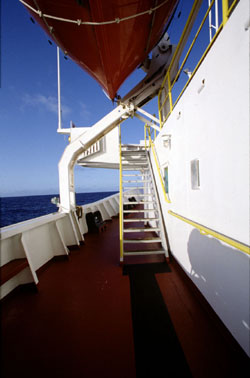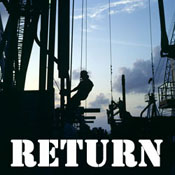Janus Project Phase 1
The purpose of the JANUS Project is to replace the current data management
system on the JOIDES Resolution and at the ODP facilities at TAMU. This
system will support the electronic data collecting, archiving, and distributing
needs of the Joint Oceanographic Institutions Deep Earth Sciences (JOIDES)
Ocean Drilling Program.
Miami Port Call
 Installation of the key hardware components for the JANUS Project was
completed on schedule during the 2½-day Leg 165 port call in Miami. The
DIGITAL UNIX operating system, DECSAFE failover software, and ORACLE
client/server environment that had been installed previously (configured and
tested during the weeks before Leg 165) were verified to be functional in the
shipboard network environment.
Installation of the key hardware components for the JANUS Project was
completed on schedule during the 2½-day Leg 165 port call in Miami. The
DIGITAL UNIX operating system, DECSAFE failover software, and ORACLE
client/server environment that had been installed previously (configured and
tested during the weeks before Leg 165) were verified to be functional in the
shipboard network environment.
Installation of the JANUS hardware components was a combined effort by
ODP/TAMU and TRACOR personnel. Because of the short length of the port
call, the DEC Alpha servers had to be up and running again by the second day in
port (December 20) to verify that the hardware components had survived the trip
from College Station.
After assembly, the Alpha servers (hudson and byrd) were booted up and testing
began. A Pentium PC and a PowerMac were installed in the library conference
room, designated as the "JANUS development" area for the duration of the
testing phase. A second PC (a 486) was installed in the core entry area for
eventual testing of the new corelog and sample data entry applications.
Two Tracor representatives sailed during Leg 165 to help with software testing.
Current Status (3/4/96)
Group 1 (Corelog data, sample data, and chemical samples):
As scheduled, Tracor implemented the majority of the Group 1 components on
Leg 165. As decided at the Steering Committee meeting held in September 1995,
operations applications are undergoing shipboard testing during Leg 166. Small
incompatibility problems associated with the multiplatform use of Neuron Data
have yet to be resolved. Testing is nearly complete, with approximately 3
person-weeks remaining in core tracking and depths generation/reporting.
Approximately 4 weeks' work remains in core sampling applications. Integration
of the composite depth sections and core correlation software with the database
(a primary recommendation of previous JOIDES and ODP/TAMU workshops)
also awaits completion. The Borehole Research Group (BRG) must be able to
interface its correlation software (currently in development) with Oracle.
Group 2a (MST, color reflectance, paleomagnetism,
geochemistry, and quad combo logs):
At its April 1995 meeting, the Steering Committee expressed a desire to have the
MST, logging, and Group 3 applications 100% functional and ready for
shipboard testing by Leg 165. Although this recommendation has not been met,
Tracor has completed shipboard testing of the MST component of Group 2b and
partially completed shipboard testing of the logging component. Only minor
modifications and debugging remain for the MST. The logging component
requires additional reporting software, a logging dictionary, and modifications to
the data model so that processed logging data can be incorporated. The
performance of logging applications using the Macintosh network was a
significant concern during Leg 165. This problem should be alleviated when the
BRG upgrades its Sun workstations from SunOS to Solaris 2.x. Review and
testing of logging applications will continue during Leg 166T. Although
incomplete, the Steering Committee views the developments that have been
implemented in Group 2a as approximately on schedule.
Group 2b (Paleontology, age profiles, and smear slides):
Shipboard testing of the paleontological applications will begin during Leg 167.
Group 3 (Physical Properties Laboratory, Adara, and WSTP):
Shipboard testing of the physical properties applications was not undertaken
during Leg 165. Furthermore, no prototyping in Group 3 was made beyond
measuring moisture density. Coordinating the different platforms still in
development and interfacing between Labview, Neuron Data, and Oracle were
cited as the primary explanations for the delay. The physical properties
components will now be tested during Leg 166T.
Given the completion level of the Group 1 and 2b components, the Steering
Committee views this delay as acceptable. However, any further delays in
testing the Group 3 components will be detrimental to the overall delivery of the
JANUS Project. For example, delays in testing the Group 3 components have
affected the development of Group 4a, which will now be tested during Leg
166T, as well as subsequent groups. Consequently, a review of the status of
Group 3 will be conducted at the end of Leg 166T by Steering Committee
members on board the transit. If continued slippage in the implementation and
testing schedule is perceived, then the Steering Committee may convene an
onshore meeting shortly thereafter.
Group 4a (Chemistry Laboratory and XRF/XRD):
Deployment and testing of the Chemistry Laboratory software was originally
scheduled to take place during Leg 166. However, prototyping has not yet begun,
nor has the data model been finalized. Marshall Bruni (Tracor) and Bill Mills
are sailing during Leg 166 to complete an analysis of the environment. Testing
has been deferred to Leg 166T.
Because User Group 4a had requested the Shipboard Measurements Panel
(SMP) to provide guidance in regard to certain measurements, Tracor personnel
postponed development of this group until they received further information on
this matter. SMP Chair Joris Gieskes quickly resolved this issue in April 1996,
and the Steering Committee fully expects that testing of the Group 4a applications
will take place during Leg 166T.
Groups 4b/5 (Sediment/structural descriptions, hard-rock and
thin-section descriptions):
Tracor has informed the Steering Committee that the User Group 4b/5 core
description requirements, developed at the core description workshop (i.e., fully
implemented digital core imaging) and thus the Group 4b/5 applications, will
probably not be completed under the current contract for two reasons: (1) the
lack of an acquisition system to collect digital images, as well as the lack of
functional specifications for description; and (2) resource allocation-in the face
of other developments, there are no Tracor personnel to allot to the digital core
imaging effort. With an optimistic view to acquiring additional funds, a meeting
was scheduled in College Station (28-29 March 1996) to define the functional
specifications for a digital image-based core description system.
Revised Schedule:
Leg 165-Group 3 testing deferred to 166T.
Leg 166-Group 4a testing deferred to 166T.
Leg 167-Group 2b testing. Because of the high core recovery rates expected, no other deployment has been scheduled for this leg.
Leg 168-Original schedule (i.e., new system to go on-line with fully integrated testing) postponed to Leg 169.
Leg 169-New system on line (including Group 4b/5 applications, as recommended by the Steering Committee.)
Application Developments
The Applications Development Group is currently involved in several projects
designed to improve and enhance the new JANUS computing environment. These
include: JANUSWEB, Moisture-Density, FossiList, Repository Sampling,
Bibliographic Application, and Materials Management.

To Semiannual Report Contents
To Project Summaries Contents